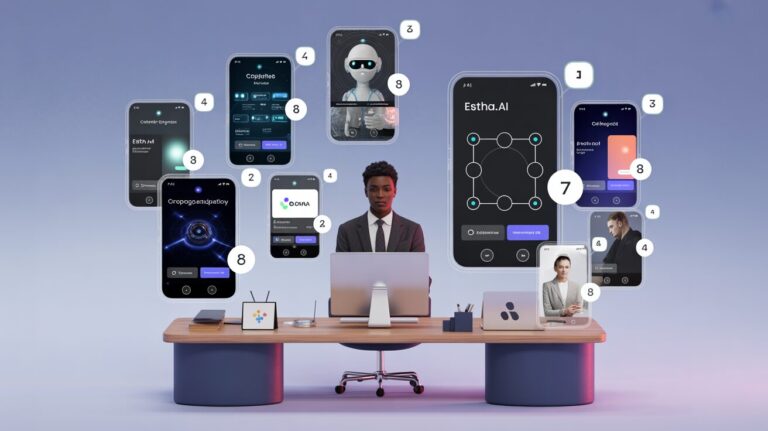Table Of Contents
- Introduction
- Understanding AI UX: Why It Matters for Non-Technical Teams
- Core Principles of AI UX Design for Non-Technical Teams
- Common AI UX Challenges for Non-Technical Teams
- Practical Strategies for Implementing AI UX Best Practices
- Measuring Success: Evaluating Your AI UX Design
- Case Studies: Successful AI UX Implementations by Non-Technical Teams
- Tools and Resources for Non-Technical Teams
- Conclusion
AI UX Best Practices for Non-Technical Teams: Creating Intuitive AI Experiences Without Coding
Artificial intelligence has moved beyond the exclusive domain of developers and data scientists. Today, professionals across all industries are embracing AI to enhance their workflows, create innovative solutions, and deliver more value to their audiences. However, creating AI applications with exceptional user experiences has traditionally required technical expertise that many teams simply don’t have. The good news? You don’t need to write a single line of code to create AI experiences that delight users.
As AI becomes increasingly democratized, non-technical teams in marketing, customer service, education, healthcare, and beyond are finding themselves responsible for implementing AI solutions. The challenge lies not in the technology itself, but in designing intuitive interfaces and experiences that make AI accessible, trustworthy, and valuable to end users.
In this comprehensive guide, we’ll explore the essential UX principles that non-technical teams should apply when creating AI applications. From establishing clear user expectations to designing transparent feedback systems, you’ll discover practical strategies that can be implemented without coding knowledge. Whether you’re building your first AI chatbot or refining an existing virtual assistant, these best practices will help you create AI experiences that users will love to engage with.
AI UX Best Practices for Non-Technical Teams
Creating Intuitive AI Experiences Without Coding
Transparency
Clearly communicate what your AI can and cannot do. Add contextual help text and use conversational language that acknowledges limitations.
Human-Centered Design
Start with user needs, not AI capabilities. Conduct interviews to understand pain points and create personas to represent your target users.
Feedback Systems
Provide clear indications of what the AI is doing and create simple mechanisms for users to correct mistakes when they occur.
Progressive Disclosure
Present information gradually to avoid overwhelming users. Start with essential functions and reveal advanced features as users become comfortable.
Common Challenges & Solutions
Managing Expectations
Set realistic expectations through clear communication about AI capabilities and provide examples of successful interactions.
Handling Errors
Design helpful error states that acknowledge mistakes, explain why they occurred, and offer alternative paths forward.
Balancing Automation
Find the right balance between AI automation and user control by identifying which tasks are best for each approach.
Implementation Steps for Non-Technical Teams
Define Purpose
Identify specific user problems your AI will solve
User Research
Conduct interviews and create personas
Design Interface
Create simple, intuitive interaction flows
Test & Refine
Gather feedback and iterate continuously
Measuring Success
Engagement Metrics
Track session duration, frequency of use, and task completion rates
Satisfaction Metrics
Implement simple feedback mechanisms like thumbs up/down buttons after AI interactions
Error Metrics
Monitor how often your AI fails to understand or correctly respond to user inputs
Ready to Create Your Own AI Experience?
Build custom AI applications in minutes, not months – no technical expertise required.
Understanding AI UX: Why It Matters for Non-Technical Teams
AI user experience (UX) design focuses on creating interfaces and interactions between humans and AI systems that feel natural, intuitive, and valuable. For non-technical teams, understanding the fundamentals of AI UX is crucial because it directly impacts user adoption, trust, and the overall success of AI implementations.
Unlike traditional UX design, AI UX involves unique considerations related to the learning, adaptive, and sometimes unpredictable nature of AI systems. Users interact with AI differently than they do with standard digital interfaces, often expecting more human-like interactions while simultaneously being wary of AI capabilities.
When non-technical teams prioritize AI UX design, they bridge the gap between powerful AI capabilities and user needs. This leads to higher engagement rates, more successful outcomes, and better ROI on AI investments. Importantly, good AI UX makes advanced technology accessible to everyone, regardless of their technical proficiency.
The democratization of AI development through no-code platforms like Estha has made it possible for teams without technical backgrounds to create sophisticated AI applications. However, the ability to build doesn’t automatically translate to building well. That’s where understanding AI UX principles becomes essential for non-technical creators.
Core Principles of AI UX Design for Non-Technical Teams
Transparency and Setting Clear Expectations
Users need to understand what your AI can and cannot do. Being transparent about capabilities prevents frustration and builds trust. When designing your AI application, clearly communicate its purpose, limitations, and how it processes information. For example, if your AI chatbot can only answer questions about specific topics, make that clear from the start.
Non-technical teams can implement transparency by creating clear onboarding experiences that explain the AI’s capabilities, adding contextual help text throughout the interface, and using conversational language that acknowledges the AI’s limitations when appropriate.
Human-Centered Design Approach
Always start with user needs rather than AI capabilities. Before building your AI application, identify specific problems your users face and how AI can solve them. This prevents the common pitfall of implementing AI for its own sake rather than as a solution to real user needs.
Conduct user interviews and surveys to understand pain points, observe how users currently complete tasks without AI, and create personas that represent your target users. These research activities don’t require technical knowledge but provide crucial insights for designing relevant AI experiences.
Clear Feedback Systems
AI systems should provide clear indications of what they’re doing, what they’ve understood, and what actions they’ve taken. This feedback loop helps users understand the system’s behavior and builds confidence in the interaction.
Non-technical teams can implement effective feedback systems by using visual indicators to show when the AI is processing information, providing summaries of what the AI has understood before taking action, and creating simple mechanisms for users to correct the AI when it makes mistakes.
Progressive Disclosure
Present information and options gradually to avoid overwhelming users. Start with the most essential functions and reveal more advanced features as users become comfortable with the basics. This approach is particularly important for AI applications, which can often perform complex functions that might intimidate new users.
Implement this principle by designing a streamlined initial experience focused on core functionality, using expandable sections for additional information, and creating “advanced mode” options for users who want more control over the AI’s behavior.
Common AI UX Challenges for Non-Technical Teams
Non-technical teams often face specific challenges when designing AI user experiences. Understanding these challenges is the first step toward addressing them effectively.
Managing User Expectations
Users often have inflated expectations about AI capabilities, shaped by science fiction and marketing hype. When the AI doesn’t perform as expected, disappointment can lead to abandonment. Non-technical teams should focus on setting realistic expectations through clear communication about what the AI can do, providing examples of successful interactions, and using language that accurately reflects the AI’s capabilities without anthropomorphizing it too much.
Handling Errors Gracefully
AI systems will make mistakes, and how your application handles these errors significantly impacts user trust. Design error states that are helpful rather than frustrating by acknowledging the error clearly, explaining why it might have occurred if possible, and offering alternative paths forward. For example, if your AI chatbot doesn’t understand a question, it should acknowledge this limitation and suggest related topics it can help with instead.
Balancing Automation and Control
Finding the right balance between AI automation and user control is challenging. Too much automation can make users feel powerless, while too little defeats the purpose of using AI. Address this challenge by identifying which tasks are best automated fully, which require human oversight, and which should remain entirely manual. Then design interfaces that make it clear when the AI is taking action and provide override mechanisms for users to take control when needed.
Practical Strategies for Implementing AI UX Best Practices
Conversational Design Principles
For AI applications that involve conversation (like chatbots or virtual assistants), following conversational design principles is essential. Create a consistent personality for your AI that aligns with your brand voice. Write responses that are concise, helpful, and natural-sounding. Include variety in responses to avoid repetition that might make the AI feel robotic.
Non-technical teams can implement these principles by creating a simple personality guide for the AI, developing response templates for common scenarios, and including friendly acknowledgments when the AI doesn’t understand something.
Visual Design Elements
Visual design plays a crucial role in communicating how AI works and guiding user interactions. Use visual cues to indicate when AI is processing information, distinguish between AI-generated content and human content, and highlight actions the user can take to interact with the AI.
Even without design expertise, non-technical teams can implement basic visual design principles by using consistent color coding (e.g., a specific color for AI-generated content), adding simple animations to show processing status, and utilizing familiar icons to indicate different AI capabilities.
Iterative Testing and Refinement
AI UX design is inherently iterative, requiring continuous testing and refinement based on user feedback. Set up simple testing protocols where team members or representative users interact with your AI application while you observe their experience.
Look for points of confusion, unexpected behaviors, or features that users particularly value. Use these insights to refine your AI application over time. This iterative approach is accessible to non-technical teams and often more effective than trying to build the perfect AI experience from the start.
Personalization Without Complexity
AI excels at personalization, but implementing personalized experiences can seem daunting for non-technical teams. Start with simple personalization based on explicit user choices rather than complex algorithms. For example, allow users to select topics they’re interested in or preferred interaction styles.
As your understanding of users grows, gradually introduce more sophisticated personalization based on observed behavior patterns. No-code AI platforms like Estha make it possible to implement personalization without writing complex code, allowing you to create custom experiences that adapt to different user needs.
Measuring Success: Evaluating Your AI UX Design
How do you know if your AI UX design is effective? Establishing the right metrics helps non-technical teams evaluate success and identify areas for improvement.
Engagement Metrics
Track how users interact with your AI application through metrics like session duration, frequency of use, and completion rates for key tasks. Increasing engagement over time suggests your AI UX is providing value and creating positive experiences. Most no-code AI platforms provide basic analytics that non-technical teams can use to monitor these metrics without data analysis expertise.
Satisfaction Metrics
Direct feedback from users provides crucial insights into their experience with your AI application. Implement simple feedback mechanisms like thumbs up/down buttons after AI interactions, short satisfaction surveys, or open comment fields. Review this feedback regularly to identify patterns and prioritize improvements.
Error Metrics
Monitor how often your AI fails to understand or correctly respond to user inputs. High error rates in specific areas highlight opportunities for improvement. Look for patterns in these errors—they often reveal assumptions about how users would interact with your AI that didn’t match reality.
Case Studies: Successful AI UX Implementations by Non-Technical Teams
Education: Interactive Learning Assistant
A team of educators with minimal technical experience used a no-code AI platform to create an interactive learning assistant for their online courses. They applied AI UX best practices by clearly defining the assistant’s role (answering questions about course material, not general knowledge), creating a friendly but professional persona that matched their teaching style, and designing a simple feedback system where students could indicate whether the assistant’s answers were helpful.
The result was a 40% increase in student engagement with course materials and significantly fewer basic questions sent to human instructors, allowing them to focus on more complex student needs.
Healthcare: Patient Screening Tool
A small healthcare practice developed an AI screening tool to help patients understand whether their symptoms warranted an appointment. The non-technical administrative team implemented key AI UX principles by using simple, non-medical language in the interface, clearly explaining that the tool was for initial guidance only (not diagnosis), and designing a transparent process that showed patients how their responses led to specific recommendations.
This implementation reduced unnecessary appointments by 25% while ensuring patients with potentially serious conditions sought care promptly. The clear expectation setting was crucial to the tool’s success, preventing both overreliance and dismissal of the AI guidance.
Tools and Resources for Non-Technical Teams
Non-technical teams have more resources than ever to create effective AI UX designs without coding knowledge.
No-Code AI Development Platforms
Estha stands out as a comprehensive solution for non-technical teams looking to create AI applications with excellent UX. Its drag-drop-link interface eliminates the need for coding while providing the flexibility to create sophisticated, personalized AI experiences. The platform’s intuitive design mirrors the AI UX best practices discussed in this article, making it easier to implement them in your own AI applications.
Other useful tools include UX templates specifically designed for AI interfaces, pre-built conversation flows for common scenarios, and visual design systems that can be customized without design expertise.
Learning Resources
For teams looking to deepen their understanding of AI UX, resources like online courses specifically focused on conversational design, user research techniques for AI applications, and case study libraries showcasing successful implementations can be invaluable. Many of these resources are designed with non-technical audiences in mind, avoiding jargon and focusing on practical applications.
Communities of practice where non-technical AI creators can share experiences, solutions, and advice also provide ongoing support for teams implementing AI UX best practices. These communities often include forums, regular webinars, and shared resource libraries.
Conclusion
Creating exceptional AI user experiences doesn’t require a technical background or coding skills. By understanding and applying key AI UX principles—transparency, human-centered design, clear feedback systems, and progressive disclosure—non-technical teams can develop AI applications that users find intuitive, trustworthy, and valuable.
The democratization of AI through no-code platforms has opened up unprecedented opportunities for teams across all industries to harness AI’s power. However, the ability to create AI applications must be paired with thoughtful UX design to truly deliver value. By following the best practices outlined in this guide, non-technical teams can ensure their AI implementations enhance user experiences rather than creating friction.
Remember that AI UX design is an iterative process. Start with the fundamentals, gather user feedback, and continuously refine your approach. With each iteration, your AI applications will become more intuitive and better aligned with user needs, delivering increasingly valuable experiences that drive adoption and engagement.
As AI continues to evolve, the principles of good UX design remain constant: understand your users, set clear expectations, provide helpful feedback, and always prioritize human needs over technological capabilities. By keeping these principles at the center of your AI development process, non-technical teams can create AI experiences that truly empower users.
Ready to Create Your Own AI Experience?
Put these AI UX best practices into action with Estha’s intuitive no-code platform. Build custom AI applications in minutes, not months – no technical expertise required.



